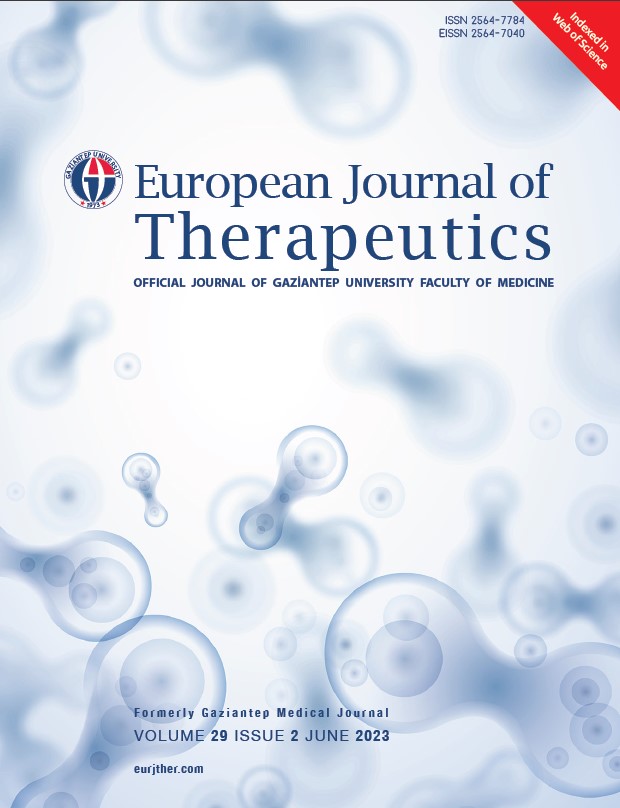Determination of Reference Intervals of Biochemistry Parameters in healthy individuals in Gaziantep Province
DOI:
https://doi.org/10.58600/eurjther.20232902-1343.yKeywords:
Reference interval, biochemistry tests, direct method, regional differencesAbstract
A correction to this article has been published on 15 March 2024.
Correction to; https://doi.org/10.58600/eurjther2088
Objective: Reference values have gained universal acceptance as the most powerful material that helps the decision-making-implementation process of the clinical laboratory. These values may be affected by the geographical location, dietary habits, and other lifestyle changes of individuals applying to the clinical laboratory. Our study aims to determine the reference ranges for the biochemistry test panel, thyroid function tests, and insulin hormone levels, which are frequently needed by clinicians for the province of Gaziantep, with samples obtained from healthy individuals.
Materials and Methods: In the study phase, the selection of reference individuals was carried out using the direct method a priori. For the study group, healthy individuals (224 men, 243 women) aged 18-45 were selected. Reference intervals (95% limit) were calculated according to the non-parametric method.
Results: When the reference intervals obtained in our study were compared with the reference intervals of the manufacturer, there were differences (> 10% lower or higher) in the upper and lower limits in urea (female and male), creatinine (male), HDL (female), AST (female and male), ALT (female), GGT (female), ALP (common), Lipase (common), CK (male), iron (male), TSH (female and male) markers. Male and female reference intervals for HDL, AST, ALT, and TSH differed significantly. Manufacturer reference ranges for these parameters were common to both sexes.
Conclusion: As a result, differences were determined between most of the reference intervals obtained in our study and the reference intervals we routinely use. We think the difference in the reference intervals is due to the differences in dietary habits and environmental factors.
Metrics
References
Grasbeck R (1983) Reference value philosophy. Bull Mol Biol Med. 8:1–11.
Aslan D, Turkish Biochemistry Association Reference Ranges Calculation Course Book. Izmır, 2010
Ilcöl YO, Aslan D (2006) Use of total patient data for indirect estimation of reference intervals for 40 clinical chemical analytes in Turkey. Clin Chem Lab Med. 44(7):867-76. https://doi.org/10.1515/CCLM.2006.139
ISO 15189: Medical Laboratories-Particular Requirements for Quality and Competence. Geneva 2003.
Sumbuloglu K & Sumbuloglu V. Biostatistics. 10. ed. Hatiboglu Yayinlari. Ankara, 2002.
Clinical and Laboratory Standards Institute. Defining, Establishing, and Verifying RIs in the Clinical Laboratory; Approved Guideline. 3rd ed.Wayne, PA: CLSI;2010.
Horn PS. Pesce AJ (2003) Reference Intervals: An Update. Clin. Chim. Acta. 334: 5-23. https://doi.org/10.1016/S0009-8981(03)00133-5
Solberg HE (1987) International Federation of Clinical Chemistry (IFCC). Approved recommendation on the theory of reference values. Part 5. Statistical treatment of collected reference values. J Clin Chem Clin Biochem. 25:645-56. https://doi.org/10.1515/CCLM.2004.121
Dixon WJ (1983) Processing data for outliers. Biometrics. 9:74- 89. https://doi.org/10.2307/3001634
Barth JH (2004) Who is responsible for reference ranges? Ann Clin Biochem. 41(Pt 6):429. https://doi.org/10.1258/0004563042466730
Barth JH (2009) Reference ranges still need further clarity. Ann Clin Biochem. 46(Pt 1):1-2. https://doi.org/10.1258/acb.2008.0081
Solberg HE (1987) Approved recommendation on the theory of reference values. Part 1. The concept of reference values. J Clin Chem Clin Biochem. 25:337–342. https://doi.org/10.1016/0009-8981(87)90151-3
Enli Y, Aslan D, Akalın N, Aydın Y, Yılmazturk CG, Goçhan I, Tekinturk S, Demir S (2003) Determination of Reference Ranges by Different Methods in Individuals aged 18-40 living in Denizli. Turkish Journal of Biochemistry. 28(4): 228-45.
Burtis CA, Ashwood ER, Bruns DE. Tietz Textbook of Clinical Chemistry and Molecular Diagnostics. 5 st ed. St. Louis, Missouri; 2012, p95-118/ p.2131-2188
Ilçöl YO, Aslan D. Determination of Blood Biochemistry Profile Reference Ranges in Healthy Individuals in Bursa Province. TJB 2004; 29(2): 183-92
Satman I, Omer B, Tutuncu Y, Kalaca S, Gedik S, Dinccag N, Karsidag K, Genc S, Telci A, Canbaz B, Turker F, Yilmaz T, Cakir B, Tuomilehto J (2013) Twelve-year trends in the prevalence and risk factors of diabetes and prediabetes in Turkish adults. TURDEP-II Study Group. Eur J Epidemiol. 28(2):169-80. https://doi.org/10.1007/s10654-013-9771-5
Koloğlu S, Koloğlu B. Türkiye’de endemik guatr. Elif Matbaacılık, Ankara 1984:1-64.
Cavuşoğlu AC, Bilgili S, Erkızan O, Arıcan H, Karaca B (2010) Thyroid hormone reference intervals and the prevalence of thyroid antibodies, Turk J Med Sci. 40 (4): 665-672. https://doi.org/10.3906/sag-0906-62
Jones GR, Barker A, Tate J, Lim C-F, Robertson K (2004) The case for common reference intervals. Clin Biochem Rev. 25(2):99
Directive C. 98/79. EC concerning in vitro diagnostic devices 1998.
Personalized reference intervals: from theory to practice, Coskun A, Sandberg S, Unsal I, Serteser M, Aarsan A (2022) Crit Rev Clin Lab Sci. 59(7):501-516 https://doi.org/10.1080/10408363.2022.2070905
Downloads
Published
How to Cite
License
Copyright (c) 2023 European Journal of Therapeutics

This work is licensed under a Creative Commons Attribution-NonCommercial 4.0 International License.
The content of this journal is licensed under a Creative Commons Attribution-NonCommercial 4.0 International License.
Funding data
-
Gaziantep Üniversitesi
Grant numbers TF.11.36


















